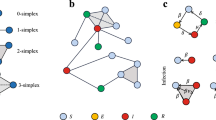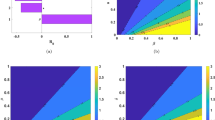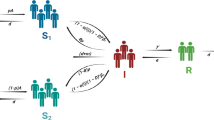Abstract
During the awareness-epidemic coupled spreading process, the self-protective actions resulted from information adoption can help to change the actual infection rate. In this paper, a UAPU-SEIR model is proposed by incorporating the impacts of information adoption and the resulting self-protective actions on epidemic transmission. Motivated by information adoption which greatly affects individuals’ subsequent behaviors, a new state abbreviated as P is introduced into the traditional unaware-aware-unaware model to describe the preventive action taken state after information adoption. Importantly, the infection rate of P-state individuals is closely related to information adoption probability. The Microscopic Markov Chain Approach (MMCA) is used to theoretically analyze the presented model and derive the outbreak threshold of epidemic. Simulation results suggest that under small epidemic infection rate, the proposed model significantly suppresses epidemic spreading speed and size, and results in higher epidemic threshold. Whereas, greater information adoption rate is needed to inhibit epidemic dissemination for increased infection rate. Besides, under the impact of information adoption and the resulted self-protective behaviors, accelerating information diffusion is able to both inhibit epidemic transmission and raise epidemic threshold. Current findings provide us a better understanding for the prevention and controlling of real infectious disease.
Graphical abstract










Similar content being viewed by others
References
S. Funk, E. Gilad, V.A. Jansen, Endemic disease, awareness, and local behavioural response. J. Theor. Biol. 264, 501–509 (2010). https://doi.org/10.1016/j.jtbi.2010.02.032
S. Funk, E. Gilad, C. Watkins, V.A. Jansen, The spread of awareness and its impact on epidemic outbreaks. Proc. Natl. Acad. Sci. 106, 6872–6877 (2009). https://doi.org/10.1073/pnas.0810762106
V. Tangcharoensathien, N. Calleja, T. Nguyen, T. Purnat, M. D’Agostino, S. Garcia-Saiso, S. Briand, Framework for managing the covid-19 infodemic: methods and results of an online, crowdsourced who technical consultation. J. Medical Internet Res. 22, 19659 (2020). https://doi.org/10.2196/19659
N. Ferguson, Capturing human behaviour. Nature 446, 733–733 (2007)
Z. Wang, M.A. Andrews, Z.X. Wu, L. Wang, C.T. Bauch, Coupled disease-behavior dynamics on complex networks: A review. Phys. Life Rev. 15, 1–29 (2015). https://doi.org/10.1016/j.plrev.2015.07.006
D.M. De, C. Granell, M.A. Porter, A. Arenas, The physics of spreading processes in multilayer networks. Nat. Phys. 12, 901–906 (2016). https://doi.org/10.1038/nphys3865
A.M. Syed, L. Hjarnó, R. Krumkamp, R. Reintjes, A.R. Aro, Develo** policy options for sars and sars-like diseases-a delphi study. Glob. Public Health 5, 663–675 (2010). https://doi.org/10.1080/17441690903473220
L.O. Gostin, E.A. Friedman, A retrospective and prospective analysis of the west african ebola virus disease epidemic: robust national health systems at the foundation and an empowered who at the apex. The Lancet 385, 1902–1909 (2015). https://doi.org/10.1016/S0140-6736(15)60644-4
W.H. Organization, et al.: Coronavirus disease 2019 (covid-19): situation report (2020)
X. Chen, B.Y. Liao, L. Cheng, X. Peng, X. Xu, Y. Li, B. Ren, The microbial coinfection in covid-19. Appl. Microbiol. Biotechnol. 104, 7777–7785 (2020). https://doi.org/10.1007/s00253-020-10814-6
S. Baloch, M.A. Baloch, T. Zheng, X. Pei, The coronavirus disease 2019 (covid-19) pandemic. Tohoku J. Exp. Med. 250, 271–278 (2020). https://doi.org/10.1620/tjem.250.271
K. Dhama, S. Khan, R. Tiwari, S. Sircar, S. Bhat, Y.S. Malik, A.J. Rodriguez-Morales, Coronavirus disease 2019-covid-19. Clin. Microbiol. Rev. 33, 10–1128 (2020)
Z. Hu, Q. Cui, J. Han, X. Wang, E.I. Wei, Z. Teng, Evaluation and prediction of the covid-19 variations at different input population and quarantine strategies, a case study in guangdong province, china. Int. J. Infect. Dis. 95, 231–240 (2020). https://doi.org/10.1016/j.ijid.2020.04.010
L. Wang, J. Wang, H. Zhao, Y. Shi, K. Wang, P. Wu, L. Shi, Modelling and assessing the effects of medical resources on transmission of novel coronavirus (covid-19) in wuhan, china. Math. Biosci. Eng. 17, 2936–2949 (2020). https://doi.org/10.3934/mbe.2020165
Statistical physics of vaccination, Wang, Z. and Bauch, C.T. and Bhattacharyya, S. and d’Onofrio, A. and Manfredi, P. and Perc, M., ... and Zhao, D. Phys. Rep. 664, 1–113 (2016). https://doi.org/10.1016/j.physrep.2016.10.006
Q. Sun, Z. Wang, D. Zhao, C. **a, M. Perc, Diffusion of resources and their impact on epidemic spreading in multilayer networks with simplicial complexes. Chaos, Solitons & Fractals 164, 112734 (2022). https://doi.org/10.1016/j.chaos.2022.112734
S. Samanta, S. Rana, A. Sharma, A.K. Misra, J. Chattopadhyay, Effect of awareness programs by media on the epidemic outbreaks: A mathematical model. Appl. Math. Comput. 219, 6965–6977 (2013). https://doi.org/10.1016/j.amc.2013.01.009
Z.K. Zhang, C. Liu, X.X. Zhan, X. Lu, C.X. Zhang, Y.C. Zhang, Dynamics of information diffusion and its applications on complex networks. Phys. Rep. 651, 1–34 (2016). https://doi.org/10.1016/j.physrep.2016.07.002
Z.S. Wang, Q.T. Guo, S.W. Sun, C. **a, The impact of awareness diffusion on sir-like epidemics in multiplex networks. Appl. Math. Comput. 349, 134–147 (2019). https://doi.org/10.1016/j.amc.2018.12.045
C. Granell, S. Gómez, A. Arenas, Dynamical interplay between awareness and epidemic spreading in multiplex networks. Phys. Rev. Lett. 111, 128701 (2013). https://doi.org/10.1103/PhysRevLett.111.128701
C. Granell, S. Gómez, A. Arenas, Competing spreading processes on multiplex networks: awareness and epidemics. Phys. Rev. E 90, 012808 (2014). https://doi.org/10.1103/PhysRevE.90.012808
Q. Guo, X. Jiang, Y. Lei, M. Li, Y. Ma, Z. Zheng, Two-stage effects of awareness cascade on epidemic spreading in multiplex networks. Phys. Rev. E 91, 012822 (2015). https://doi.org/10.1103/PhysRevE.91.012822
W. Wang, Q.H. Liu, S.M. Cai, M. Tang, L.A. Braunstein, H.E. Stanley, Suppressing disease spreading by using information diffusion on multiplex networks. Phys. Rep. 6, 29259 (2016). https://doi.org/10.1038/srep29259
C. Zheng, C. **a, Q. Guo, M. Dehmer, Interplay between sir-based disease spreading and awareness diffusion on multiplex networks. J Parallel Distrib. Comput. 115, 20–28 (2018). https://doi.org/10.1016/j.jpdc.2018.01.001
C. **a, Z. Wang, C. Zheng, Q. Guo, Y. Shi, M. Dehmer, Z. Chen, A new coupled disease-awareness spreading model with mass media on multiplex networks. Inf. Sci. 471, 185–200 (2019). https://doi.org/10.1016/j.ins.2018.08.050
Z.S. Wang, C.Y. **a, Co-evolution spreading of multiple information and epidemics on two-layered networks under the influence of mass media. Nonlinear Dyn. 102, 3039–3052 (2020). https://doi.org/10.1007/s11071-020-06021-7
Z. Wang, C. **a, Z. Chen, G. Chen, Epidemic propagation with positive and negative preventive information in multiplex networks. IEEE Trans. Cybern 51(3), 1454–1462 (2020). https://doi.org/10.1109/TCYB.2019.2960605
J. Wu, R. Zuo, C. He, H. **ong, K. Zhao, Z. Hu, The effect of information literacy heterogeneity on epidemic spreading in information and epidemic coupled multiplex networks. Phys. A 596, 127119 (2022). https://doi.org/10.1016/j.physa.2022.127119
J. Fan, Q. Yin, C. **a, M. Perc, Epidemics on multilayer simplicial complexes. P. ROY. SOC. A 478(2261), 20220059 (2022). https://doi.org/10.1098/rspa.2022.0059
C.-M.K. Cheung, M.-K.O. Lee, N. Rabjohn, The impact of electronic word-of-mouth: The adoption of online opinions in online customer communities. Internet Res. 18, 229–247 (2008). https://doi.org/10.1108/10662240810883290
E. Massaro, F. Bagnoli, Epidemic spreading and risk perception in multiplex networks: A self-organized percolation method. Phys. Rev. E 90, 052817 (2014). https://doi.org/10.1051/proc/201549005
L. Danon, A.P. Ford, T. House, C.P. Jewell, M.J. Keeling, G.O. Roberts, M.C. Vernon, Networks and the epidemiology of infectious disease. Interdiscip Perspect Infect. Dis. 2011, 5896 (2011). https://doi.org/10.1155/2011/284909
J.K. Matt, R. Pejman, Modeling Infectious Diseases in Humans and Animals. Princeton University Press, Princeton (2008). https://doi.org/10.1086/591197
S. Gómez, A. Arenas, J. Borge-Holthoefer, S. Meloni, Y. Moreno, Discrete-time markov chain approach to contact-based disease spreading in complex networks. EPL 89, 38009 (2010). https://doi.org/10.1209/0295-5075/89/38009
S. Gómez, J. Gómez-Gardenes, Y. Moreno, A. Arenas, Nonperturbative heterogeneous mean-field approach to epidemic spreading in complex networks. Phys. Rev. E 84, 036105 (2011). https://doi.org/10.1103/PhysRevE.84.036105
M. Boguná, C. Castellano, R. Pastor-Satorras, Langevin approach for the dynamics of the contact process on annealed scale-free networks. Phys. Rev. E 79, 036110 (2009). https://doi.org/10.1103/PhysRevE.79.036110
T. Britton, M. Deijfen, A. Martin-Löf, Generating simple random graphs with prescribed degree distribution. J. Stat. Phys. 124, 1377–1397 (2006). https://doi.org/10.1007/s10955-006-9168-x
M. Catanzaro, M. Boguná, R. Pastor-Satorras, Generation of uncorrelated random scale-free networks. Phys. Rev. E 71(2), 027103 (2005). https://doi.org/10.1103/PhysRevE.71.027103
Acknowledgements
This work was supported by (i) Project supported by the National Natural Science Foundation of China (Grant No. 62366028); (ii) Gansu Provincial Science and Technology Plan Project, China (Grant No. 21ZD8RA008); (iii) Project supported by the Natural Science Foundation of Gansu Province, China (Grant No. 23JRRA1688); (iv) The Support Project for Youth Doctor in Colleges and Universities of Gansu Province (Grant No. 2023QB-038); (v) The Science and Technology Plan Project of Lanzhou City (Grant No. 2021-1-150).
Author information
Authors and Affiliations
Contributions
Conceptualization, H.-Y.P.; methodology, H.-Y.P. and Y.D.; software, G.-H.Y. and Y.D.; validation, H.-Y.P. and Y.D.; writing-original draft, G.-H.Y.; writing-review and editing, H.-Y.P. and Y.D.. All authors have read and agreed to the published version of the manuscript.
Corresponding author
Rights and permissions
Springer Nature or its licensor (e.g. a society or other partner) holds exclusive rights to this article under a publishing agreement with the author(s) or other rightsholder(s); author self-archiving of the accepted manuscript version of this article is solely governed by the terms of such publishing agreement and applicable law.
About this article
Cite this article
Pei, H., Ding, Y. & Yan, G. Impact of information adoption and the resulted self-protective actions on epidemic spreading in awareness-disease coupled multiplex networks. Eur. Phys. J. B 97, 52 (2024). https://doi.org/10.1140/epjb/s10051-024-00693-5
Received:
Accepted:
Published:
DOI: https://doi.org/10.1140/epjb/s10051-024-00693-5




